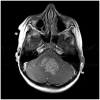Improving Care in Pediatric Neuro-oncology Patients: An Overview of the Unique Needs of Children With Brain Tumors
- PMID: 26245798
- PMCID: PMC5032907
- DOI: 10.1177/0883073815597756
Improving Care in Pediatric Neuro-oncology Patients: An Overview of the Unique Needs of Children With Brain Tumors
Abstract
Brain tumors represent the most common solid tumors in childhood, accounting for almost 25% of all childhood cancer, second only to leukemia. Pediatric central nervous system tumors encompass a wide variety of diagnoses, from benign to malignant. Any brain tumor can be associated with significant morbidity, even when low grade, and mortality from pediatric central nervous system tumors is disproportionately high compared to other childhood malignancies. Management of children with central nervous system tumors requires knowledge of the unique aspects of care associated with this particular patient population, beyond general oncology care. Pediatric brain tumor patients have unique needs during treatment, as cancer survivors, and at end of life. A multidisciplinary team approach, including advanced practice nurses with a specialty in neuro-oncology, allows for better supportive care. Knowledge of the unique aspects of care for children with brain tumors, and the appropriate interventions required, allows for improved quality of life.
Keywords: brain tumor; neuro-oncology; pediatric; quality of life.
© The Author(s) 2015.
Conflict of interest statement
Declaration of conflicting interests The authors have no conflicts of interest in relation to this manuscript.
Figures




Similar articles
-
Clinical trials in pediatric neuro-oncology: what is missing and how we can improve.CNS Oncol. 2016 Oct;5(4):233-9. doi: 10.2217/cns-2016-0016. Epub 2016 Sep 12. CNS Oncol. 2016. PMID: 27616346 Free PMC article. Review.
-
Introduction to a special issue on pediatric neuro-oncology.J Child Neurol. 2009 Nov;24(11):1341-2. doi: 10.1177/0883073809338959. J Child Neurol. 2009. PMID: 19841423 No abstract available.
-
Challenges and opportunities to advance pediatric neuro-oncology care in the developing world.Childs Nerv Syst. 2015 Aug;31(8):1227-37. doi: 10.1007/s00381-015-2771-x. Epub 2015 Jun 4. Childs Nerv Syst. 2015. PMID: 26040936 Review.
-
Brain tumors in children.Curr Oncol Rep. 2004 Nov;6(6):438-44. doi: 10.1007/s11912-004-0074-6. Curr Oncol Rep. 2004. PMID: 15485612 Review.
-
Advances in Radiation Therapy in Pediatric Neuro-oncology.J Child Neurol. 2016 Mar;31(4):506-16. doi: 10.1177/0883073815597758. Epub 2015 Aug 13. J Child Neurol. 2016. PMID: 26271789 Review.
Cited by
-
Sex-related incidence and survival differences in pediatric high-grade glioma subtypes: A population-based cohort study.iScience. 2023 Sep 17;26(10):107957. doi: 10.1016/j.isci.2023.107957. eCollection 2023 Oct 20. iScience. 2023. PMID: 37810231 Free PMC article.
-
Patterns, clinical presentations, and time to diagnosis in pediatric central nervous system tumors: insights from a pediatric neuro-oncology tumor board team at a tertiary referral hospital in Ethiopia.J Neurooncol. 2025 Sep;174(3):587-598. doi: 10.1007/s11060-025-05040-x. Epub 2025 Jun 13. J Neurooncol. 2025. PMID: 40512283
-
The Management of Childhood Intracranial Tumours and the Role of the Ophthalmologist.Neuroophthalmology. 2019 May 3;43(6):375-381. doi: 10.1080/01658107.2019.1597130. eCollection 2019 Dec. Neuroophthalmology. 2019. PMID: 32165896 Free PMC article.
-
A multidisciplinary team care approach improves outcomes in high-risk pediatric neuroblastoma patients.Oncotarget. 2017 Jan 17;8(3):4360-4372. doi: 10.18632/oncotarget.13874. Oncotarget. 2017. PMID: 27966455 Free PMC article.
-
Role of global neurosurgery in tackling pediatric brain tumors: an insight.Childs Nerv Syst. 2024 Dec 30;41(1):75. doi: 10.1007/s00381-024-06742-9. Childs Nerv Syst. 2024. PMID: 39738620 No abstract available.
References
-
- Kahn K, Finkel A. It IS a tumor -- current review of headache and brain tumor. Current pain and headache reports. 2014;18:421. - PubMed
-
- Duffner PK. Diagnosis of brain tumors in children. Expert review of neurotherapeutics. 2007;7:875–85. - PubMed
-
- Crawford J. Childhood brain tumors. Pediatrics in review / American Academy of Pediatrics. 2013;34:63–78. - PubMed
Publication types
MeSH terms
Grants and funding
LinkOut - more resources
Full Text Sources
Other Literature Sources
Medical

